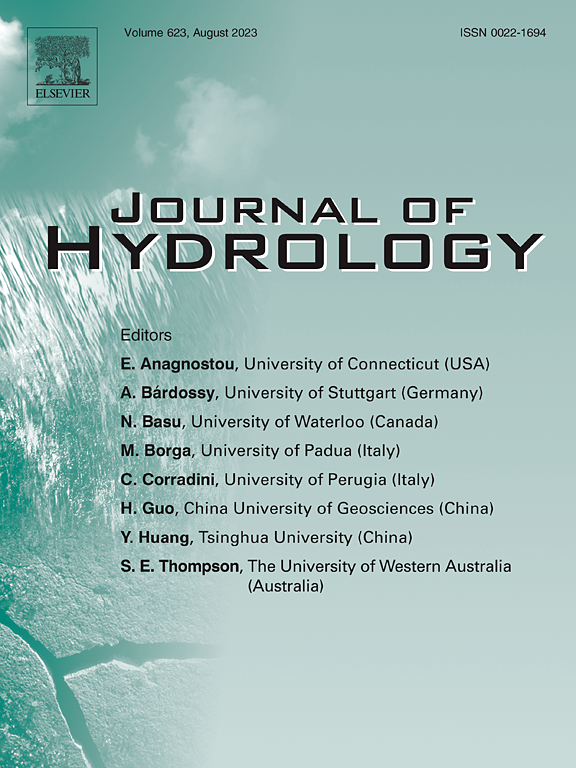鼠李糖脂包覆臭氧微纳泡水注入联合地下水抽吸强化低渗透带甲苯修复
IF 5.9
1区 地球科学
Q1 ENGINEERING, CIVIL
引用次数: 0
摘要
地下水中的有机污染物往往聚集在低渗透带,这是很难完全修复的。鼠李糖脂包覆的臭氧微纳气泡直径在1 ~ 100 μm之间,具有渗透到LPZ中氧化有机污染物的潜力。然而,它们容易附着在多孔介质上,限制了臭氧的传输距离,降低了修复效率。通过二维砂槽实验,研究了鼠李糖脂包覆臭氧微纳泡水(ROMBW)注入结合地下水抽吸对LPZ中甲苯的去除率。结果表明,组合工艺对LPZ中甲苯的最终去除率达到96.2%,高于不抽地下水注入ROMBW(92.0%)。此外,鼠李糖脂的添加也使LPZ的甲苯去除率提高了0.8%。成功地建立了模拟砂槽中甲苯最终浓度的数值模型,平均误差为2.17 mg/L,证明了LPZ中甲苯去除率的提高主要是由于更多的纳米气泡渗透到LPZ中。此外,该模型还表明,ROMBW的总注入体积是控制修复效率的最重要因素,LPZ周围较短的筛管长度以及筛管与LPZ之间较近的距离提高了修复效率。本研究结果可指导臭氧微纳泡氧化技术在非均质含水层修复中的应用。本文章由计算机程序翻译,如有差异,请以英文原文为准。
Enhanced toluene remediation in low-permeability zone by injecting rhamnolipid-coated ozone micro-nano bubble water combined with groundwater pumping
Organic contaminants in groundwater always tend to accumulate in low-permeability zone (LPZ), which are difficult to be completely remediated. Rhamnolipid-coated ozone micro-nano bubbles have very tiny diameters ranging from 1 nm to 100 μm, which have potential to permeate into LPZ to oxidize organic contaminants. However, they are easily attached on porous media, limiting the transport distance of ozone and reducing the remediation efficiency. This paper carried out two-dimensional sand tank experiments to investigate the toluene removal rate in LPZ by the injection of rhamnolipid-coated ozone micro-nano bubble water (ROMBW) combined with groundwater pumping. Results showed that the final removal rate of toluene in LPZ reached 96.2 % with the combined technology, which was higher than ROMBW injection without groundwater pumping (92.0 %). Besides, the addition of rhamnolipid also slightly increased the toluene removal rate in LPZ by 0.8 %. A numerical model was successfully developed to simulate the final toluene concentration in the sand tank with the average error of 2.17 mg/L, which proved that the improved removal rate of toluene in LPZ was mainly attributed to the permeation of more nanobubbles into LPZ. Furthermore, the model also indicated that the total injected volume of ROMBW was the most important factor that controlled the remediation efficiency, and a short screen length around LPZ as well as the close distance between well screen and LPZ improved the remediation efficiency. The findings of this study could guide the application of ozone micro-nano bubble oxidation in heterogeneous aquifer remediation.
求助全文
通过发布文献求助,成功后即可免费获取论文全文。
去求助
来源期刊

Journal of Hydrology
地学-地球科学综合
CiteScore
11.00
自引率
12.50%
发文量
1309
审稿时长
7.5 months
期刊介绍:
The Journal of Hydrology publishes original research papers and comprehensive reviews in all the subfields of the hydrological sciences including water based management and policy issues that impact on economics and society. These comprise, but are not limited to the physical, chemical, biogeochemical, stochastic and systems aspects of surface and groundwater hydrology, hydrometeorology and hydrogeology. Relevant topics incorporating the insights and methodologies of disciplines such as climatology, water resource systems, hydraulics, agrohydrology, geomorphology, soil science, instrumentation and remote sensing, civil and environmental engineering are included. Social science perspectives on hydrological problems such as resource and ecological economics, environmental sociology, psychology and behavioural science, management and policy analysis are also invited. Multi-and interdisciplinary analyses of hydrological problems are within scope. The science published in the Journal of Hydrology is relevant to catchment scales rather than exclusively to a local scale or site.
 求助内容:
求助内容: 应助结果提醒方式:
应助结果提醒方式:


